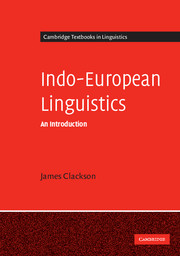Book contents
- Frontmatter
- Contents
- List of figures
- List of tables
- Preface
- Transliteration conventions
- 1 The Indo-European language family
- 2 Phonology
- 3 Morphophonology
- 4 Nominal morphology
- 5 Verbal morphology
- 6 Syntax
- 7 Lexicon and lexical semantics
- Glossary
- References
- Word index
- Language index
- Person index
- Subject index
7 - Lexicon and lexical semantics
Published online by Cambridge University Press: 05 June 2012
- Frontmatter
- Contents
- List of figures
- List of tables
- Preface
- Transliteration conventions
- 1 The Indo-European language family
- 2 Phonology
- 3 Morphophonology
- 4 Nominal morphology
- 5 Verbal morphology
- 6 Syntax
- 7 Lexicon and lexical semantics
- Glossary
- References
- Word index
- Language index
- Person index
- Subject index
Summary
The PIE lexicon
Comparative reconstruction begins with the comparison of lexical items across different languages, but most works on IE operate largely on the basis of roots and affixes rather than lexemes. The standard etymological dictionaries of IE (see Pokorny (1959), Rix et al. (1998) and Watkins (2000)) present the IE lexicon as a collection of roots, each of which has limited semantic scope and from which a number of derived stems can be formed. For example, the correspondence between Latin agō ‘I drive, lead’ and Greek ágō ‘I lead’ and Sanskrit ájāmi ‘I drive’ is listed under a root *h2eg′- (or *ag′-) rather than as a separate lexical entry, and a unified meaning is given for the root as a whole. Listed in the same dictionary entry one may find nominal derivations such as *h2eg′-mn, which is the hypothetical ancestor of Latin agmen ‘procession, military column’ and Sanskrit ájman- ‘course, procession’, or the adjectival form *h2(e)g′-to-, continued as the Latin participle āctus ‘driven’ and found in the Celtic compound ambactos ‘servant’. Furthermore, the word-equation of Latin ager ‘field’, Greek agrós ‘field’, Gothic akrs ‘field’ and Sanskrit ájras ‘plain’ is given by Pokorny and Watkins as a derivative of the same root, on the supposition that the original root was connected with animal herding, and *h2eg′-ro- designated the space into which animals were driven.
Information
- Type
- Chapter
- Information
- Indo-European LinguisticsAn Introduction, pp. 187 - 215Publisher: Cambridge University PressPrint publication year: 2007
